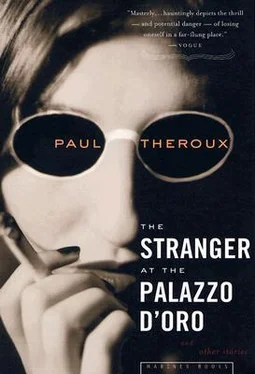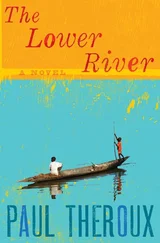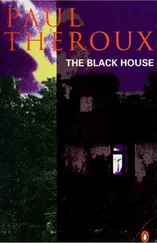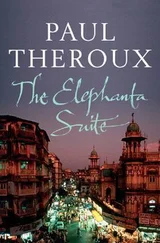The first story was the strangest. A white farmer in a remote dorp of the Free State lusted after one of his female servants. He could see that she recognized his desire, but she made no move, merely waited for him to act. He did nothing. He was nearing sixty, his wife a bit older, and “she had shut up shop some years before,” which I took to mean had lost interest in sex.
The farmer's wife was approaching a thorn tree one day to photograph a bird (a gray-headed bush shrike) when a snake (a boomslang) wrapped on a bough above her dropped to the earth and bit her. She died soon after. I was later to find that Prinsloo’s stories were full of the particularities of South African natural history.
Very soon after his wife’s death, the farmer consoled himself with his African servant. But he was so ashamed afterward that he did not repeat the deed. When the African woman appeared at his door she was turned away. Humiliated, she left his employ, but not before putting a curse on the farmer.
The farmer mourned his wife and asked her forgiveness. He took to staring in a mirror to assess his misery. One day he noticed a mole on his face that he had never seen before. Within a few days it grew larger, and soon it was “the size of a Krugerrand,” not a mole anymore but a deep brown blotch, an irregular stain that spread to cover his cheek. He could not hide it. Other parts of his body were similarly affected. The lower part of his left leg was brown. Soon his entire body was dark.
At first he dared not show his face in public, and for months — captive to his changing color — he did not leave his house. But when, inevitably, he had to go to town, he hid his dusky face. To his surprise he was not recognized, nor was he singled out — was not noticed at all. He came and went unseen by anyone, and with this new racial coloration became invisible.
He was so unrecognizable that, although he was fully present, a rumor circulated that he had died. To deny the rumor would have meant revealing himself, and so he let the rumor circulate. Hearing of his death, the African woman showed up with her child — the fruit of their brief union. She intended to stake her claim to the property, using their child as proof of what had occurred between them. The child was white. The woman was chased away by the servants, arrested for kidnapping a white child, and given a long sentence. That story was titled “The Curse.”
That element of the supernatural seemed to be a trait in Prinsloo’s work, and was more believable than the sort of thing you find in, for example, Edward Lucas White’s “Lukundoo.” In that horror story a white explorer in Africa comes down with a case of apparent measles — boils, anyway — and suffers as they grow, and at last, pricking them, he finds that each boil contains a little black man standing in his flesh, upright on the center of each eruption, looking furious. Prinsloo’s stories were subtler than that, but then Prinsloo considered himself an African.
In “Katje and Koelie,” the lives of an old woman and her servant are depicted with ironic sympathy. The women, one black, one white, the same age, have been raised together on a remote farm in the eastern Transvaal. At first they are playmates; then the black woman, Koelie, becomes Katje’s servant, washing her clothes, shining her boots. Katje teaches Koelie to read and write, and for a while the servant excels in her studies and speaks of leaving; but, hearing this, Katje forbids it, ends the lessons, and Koelie is reduced to servitude again, until Katje falls ill and is nursed by Koelie, who makes all the decisions. In middle life they have become like a married couple. Katje’s eyesight fails. Koelie becomes her eyes, and because she is literate she writes checks for Katje, deals with Katje’s money, and becomes Katje’s protector.
You think that something sinister is about to occur when Prinsloo describes them arm in arm, the black servant steering her white mistress, but it is only a characteristic death scene, one of Prinsloo’s signature devices: the white woman, sleepwalking, falls and breaks her hip, and lying an entire night, she is set upon by huge (“mouse-sized”) armored crickets ( Acanthoplus dis-coidalis ), which chew her flesh. Katje is found in the morning by Koelie, dead, part of her face eaten away. Koelie buries her lifelong friend and keeps one of the crickets, not, as the African staff thinks, for muti (medicine), but as the embodiment of Katje, now and then — this is the last paragraph — allowing the cricket to chew on her own arm.
“The Justus Family” reminded me of Arthur Schnitzler’s play Reigen: a series of ten encounters takes place, all of them sexual assignations, and all the characters change partners. In the first scene the soldier is bedding the shopgirl, in the second scene the shopgirl is being wooed by a lawyer, in the third the lawyer is pouncing on the society woman, and so forth until the last pairing, the soldier again, with the woman from the penultimate scene, linking her in this human chain to the first scene. It’s about syphilis, some critics have said; but why? Reigen is about how the world works. “The Justus Family” had a similar movement — peristaltic almost.
Prinsloo’s story, which opens with an obscure funeral, I took to be autobiographical, since there were eight children in it, the same as in Prinsloo’s family. Each of the children sought the approval of a domineering mother. Little alliances were formed among the children but none were secure; in fact, no sooner had one sibling confided in another than that one used the confidence to jeer at the sibling and take the secret to a brother or sister, who in turn passed it on, whispering it to another brother or sister, who of course broke the promise of confidence, undermining the teller and becoming the subject of more whispers. Peristalsis.
This story of apparent betrayal — no one is true, no one keeps a secret, everyone is mocked — is the more sinister and unsettling for the figure of the mother, a highly respected Boer matriarch and widow, who in fact keeps the whole process going. Her presence gives “The Justus Family” more density than Schnitzler's play, because it is more than just a round of sordid encounters; it involves complex interaction.
Whenever Mother Justus detects a note of resolution she steps in and stirs, feeding the whispers with whispers of her own, and so the story of the Justus family is really the story of this woman, whose children seem less and less malicious and more and more the victims of a manipulative and insecure mind. The shocked children realize their secrets have been betrayed. Mother Justus laughs and says, “If they were secrets, you wouldn't have told me.”
But they love and obey her, and when a black farm hand makes an offhand remark about her tyranny he is set upon by the children and killed. The obscure funeral on the first page is his.
The most ingenious and modern of Prinsloo’s long stories was one of his last, written in his period of birthday melancholy — perhaps for that reason it was his funniest, his crudest, his most unsparing. It is called “The Translator.”
The translator of the title is a wealthy farmer of citrus in Nelspruit named Finsch, who on his sixtieth birthday acquires the ability (we don't learn how, but it is so convincing we don't ask) to translate what people say to him into what they really mean. The story — novella, really — is all subtext and no text. In a verbal sense everyone who encounters Finsch is naked: nothing is hidden from him, people’s motives are baldly apparent.
I can only approximate the dialogue because I am recounting it from memory. The narrative is almost all dialogue, and the piece would make a superbly wicked play. As I mentioned earlier, I was given a thick typescript of Prinsloo’s stories at Etienne Leroux’s house. I spent a day and a night with it, and then was told to hand it back. I was not able to make notes. The only photocopier at the time and place was a big inky machine, predating the mimeograph. It was a Gestetner brand Cyclostyle machine which produced cloudy brown representations of text on crinkly curly sheets of flimsy paper that faded and became unreadable if sunlight fell upon them.
Читать дальше












